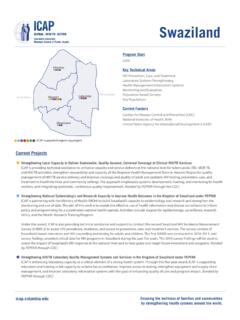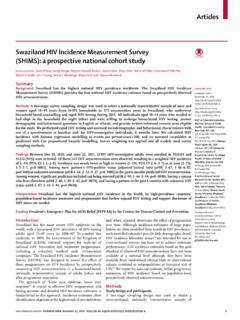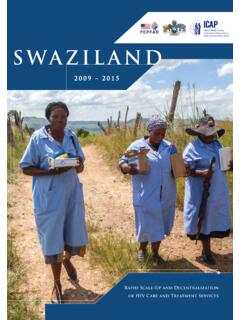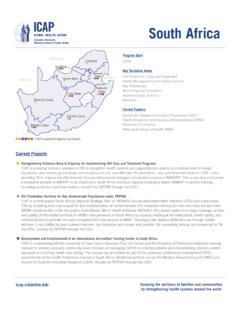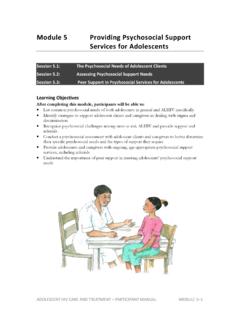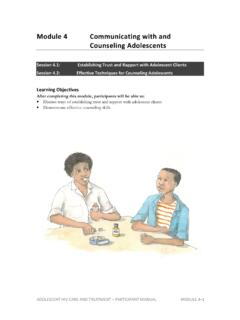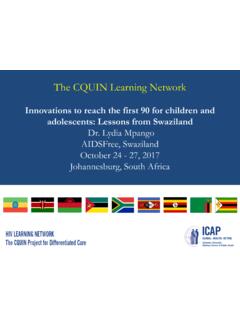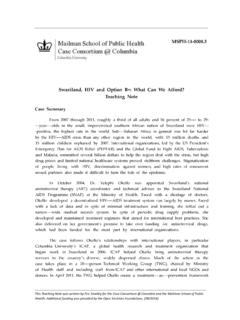Transcription of Estimating HIV Prevalence from the Swaziland HIV Incidence ...
1 Estimating HIV Prevalence from the Swaziland HIV Incidence measurement survey Rejoice Nkambule, Henry Ginindza, George Bicego, Deborah Donnell, Jessica Justman, Jason Reed, Ingrid Peterson and the SHIMS team Abstract # 142 March 8, 2012 The Kingdom of Swaziland *calculated from DHS 2006 Small country in southern Africa Population: million Demographic Health survey 2006: Overall HIV Prevalence 31% among men and women (ages 18-49)* Highest national HIV Prevalence in the world Adapted from WorldVision Male Circumcision as Part of Swaziland s Scale-Up of Combination Prevention Strateg y National combination prevention program: HIV testing and counseling PMTCT Social behavior change communication ART expansion Voluntary medical male circumcision 2010: Soka Uncobe ( Conquer through Circumcision ), the national campaign to scale-up male circumcision from 8% to 80% of adult men in one year What will be the reduction in HIV Incidence in Swaziland ?
2 Primary Objective: To estimate HIV Incidence rates in a household-based, nationally re presentative sample of men and women, before and after accelerated scale-up of HIV prevention prog rams. Cur rent Analysis To estimate HIV Prevalence rate in a household-based, nationally re presentative sample of men and women. Swaziland HIV Incidence measurement Sur vey (SHIMS) SHIMS Methods Select 575 of 2054 Enumeration Areas (EAs) Randomly select 26 households from each EA Invite all adults aged 18-49 in households to participate in cross-sectional survey Invite HIV-uninfected adults to join Incidence cohort SHIMS: Two-stage Cluster Sampling Design Resides or has sle pt the night before in selected household Age 18-49 years Able to provide consent SHIMS Sur vey.
3 Inclusion Criteria SHIMS Study team visiting a selected household Inter viewer-administered questionnaire HIV counseling and testing 4th generation Determine HIV 1/2 Antigen/Antibody Combo If HIV-positive, refer to care ser vices If HIV-negative, refer to prevention ser vices SHIMS Study Procedures SHIMS sample weighted to achieve population representativeness Weights adjust for sample selection and differences in non-response Weighting Methods Results Total Selected households 14,950 Participating households 12,597 (84%) Men Women Total Eligible household members 10,886 13,414 24,300 No contact made 2445 (22%) 1353 (10%) 3798 (16%) Refused participation 1362 (13%) 1084 (8%) 2446 (10%) Participating household members 7,079 (65%) 10,977 (82%) 18,056 (74%) SHIMS Sur vey Participation Men Women Total Age 18-24 37% 35% 36% 25-34 36% 33% 34% 35-49 27% 32% 30% Education None 6% 7% 7% Primary 27% 29% 28% Secondary 49% 50% 50% Higher 17% 14% 15% Married or living with a partner 36% 51% 44% Circumcised (self-reported)
4 15% - - Swaziland Demographics (Ages 18-49) HIV Prevalence In Swaziland : HIV+ Test in SHIMS (n= 18,056) 23% 38% 31% Men Women Total Percent HIV Seropositive 2011 HIV Prevalence IN Swaziland SHIMS survey (AGES 18-49) Men: Prevalence by Age Women: Prevalence by Age 2011 HIV Prevalence IN Swaziland SHIMS survey (AGES 18-49) Men: Prevalence by Age Women: Prevalence by Age 48% in men aged 35-39 54% in women aged 30-34 2006 DHS AND 2011 SHIMS HIV Prevalence IN Swaziland ( AG E S 1 8-49) Men: Prevalence by Age Women: Prevalence by Age 48% 32% 52% 68% Among HIV-Seropositives: Knowledge of HIV Status Unaware Aware Men Men Women Women Self-Repor ted ART Use among HIV-Seropositives *No CD4 data collected therefore results do not indicate proportion eligible for ART 58% 47% 50% 33% 34% 34% Men Men Women Women Total Total National HIV Prevalence remains high at 31% Overall HIV Prevalence stable since 2006 Shift in age-patter n of Prevalence points towards survival effect related to ART use at older ages reduced rate of new infections at younger ages Half of all HIV+ men are not aware of their status Evidence for public programs to target HTC for men Half of
5 Individuals aware of their HIV infection are on ART, ir respective of CD4 Analysis of HIV Incidence estimate in prog ress Conclusions P r o t o c o l Te a m * R e j o i c e N k a m b u l e * G e o r g e B i c e g o N a o m i B o c k M u h l e D l a m i n i D e b o r a h D o n n e l l D e n n i s E l l e n b e r g e r Te d d E l l e r b r o c k Wa f a a El-S a d r J o n a t h a n G r u n d * J e s s i c a J u s t m a n A m y M e d l e y Ja n M o o r e E m m a n u e l N j e u h m e l i * J a s o n R e e d N e l i s i w e S i k h o s a n a I C A P a t C o l u m b i a U n i ve r s i t y E l i z a b e t h B a r o n e M o n t i n a B e f u s M a r y D
6 I e h l M a r k F u s s e l l A l l i s o n G o l d b e r g L e s l i e H o r n Ja c q u e l i n e M a x w e l l J o a n M o n s e r r a t e N e e n a P h i l i p Pe t e r T w y m a n L e a h We s t r a A l l i s o n Z e r b e It Takes A Village: Nat l Ref Laboratory Hosea Sukati Sindi Dlamini All Laboratory Scientists CDC Atlanta Anindya De Joy Chang Josh DeVos Yen Duong Dennis Ellenberger Al Garcia Carole Moore John Nkengasong Michele Owen Bharat Parekh Hetal Patel Connie Sexton Barbara Suligoi Chunfu Yang CDC Swaziland Peter Ehrenkranz Ahmed Liban Khosi Makhanya SCHARP Claire Chapdu Lynda Emel Iraj Mohebalian Lei Wang Epicentre/Maromi Health Research Cherie Cawood Mark Colvin David Khanyile Nomsa Nzama Phindile Radebe All Regional Managers All field teams ICAP in Swaziland Alfred Adams Kerry Bruce Gcinekile Dlamini Ndumisi Dlamini Sindisiwe Dlamini Henry
7 Ginindza Sibuse Ginindza Alison Koler Yvonne Mavengere Khudzie Mlambo Phakamile Ndlangamandla Ingrid Peterson Nicola Pierce Bhangazi Zwane Local And Inter national Partnership Kingdom of Swaziland & CSO
